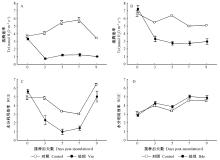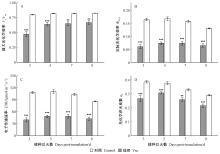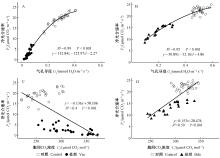

Scientia Silvae Sinicae ›› 2021, Vol. 57 ›› Issue (9): 121-129.doi: 10.11707/j.1001-7488.20210912
Previous Articles Next Articles
Junchao Xing1,Yinan Zhang1,Yan Shi2,Jinxin Li1,Min Li1,Wanna Shen1,Li Wang3,Jiaping Zhao1,*
Received:2020-05-19
Online:2021-09-25
Published:2021-11-29
Contact:
Jiaping Zhao
CLC Number:
Junchao Xing,Yinan Zhang,Yan Shi,Jinxin Li,Min Li,Wanna Shen,Li Wang,Jiaping Zhao. Comparisons of Photosynthetic Response and Characteristics in Leaves of Populus alba var. pyramidalis Infected by the Stem Canker Pathogen Valsa sordida and Botryosphaeria dothidea at Early Stage[J]. Scientia Silvae Sinicae, 2021, 57(9): 121-129.

Fig.3
The effects of pathogen inoculations on transpiration rate and water use efficiency of P. alba var. pyramidalis A and C respectively represent transpiration rate(Tr) and water use efficiency(WUE) under the stress of V. sordida(Vso). Band D respectively represent Tr and WUE under the stress of B. dothidea (Bdo)."


Fig.4
The chlorophyll fluorescence characteristics of P. alba var. pyramidalis infected by pathogen V. sordida A: The maximum photochemical efficiency(Fv/Fm); B: Actual photochemical efficiency(ΦPSⅡ); C: Electron transport rate(ETR); D: Photochemical quenching coefficient(qp). Data are the mean± standard error of 7 replicates. *P < 0.05, **P < 0.01, ***P < 0.001. The P-value represents the level of significant differences. The same below."


Fig.6
Correlations between leaf stomatal conductance, intercellular CO2 concentration and net photosynthetic rate A and C respectively represent the correlations between leaf stomatal conductance(Gs), intercellular CO2 concentration(Ci) and net photosynthetic rate (Pn)under the stress of V. sordida. B and D respectively represent the correlations between leaf stomatal conductance(Gs), intercellular CO2 concentration(Ci) and net photosynthetic rate(Pn) under the stress of B. dothidea."

|
付士磊, 周永斌, 何兴元, 等. 干旱胁迫对杨树光合生理指标的影响. 应用生态学报, 2006, 17 (11): 2016- 2019.
doi: 10.3321/j.issn:1001-9332.2006.11.004 |
|
|
Fu S L , Zhou Y B , He X Y , et al. Effects of drought stress on photosynthesis physiology of Populus pseudo-simonii. Chinese Journal of Applied Ecology, 2006, 17 (11): 2016- 2019.
doi: 10.3321/j.issn:1001-9332.2006.11.004 |
|
| 惠红霞, 许兴, 李守明. 盐胁迫抑制枸杞光合作用的可能机理. 生态学杂志, 2004, 23 (1): 5- 9. | |
| Hui H X , Xu X , Li S M . Possible mechanism of inhibition on photosynthesis of Lycium barbarum under salt stress. Chinese Journal of Ecology, 2004, 23 (1): 5- 9. | |
| 梁军, 严东辉, 张星耀. 2003. 杨树烂皮病//张星耀, 骆有庆. 中国森林重大生物灾害. 北京: 中国林业出版社, 120-139. | |
| Liang J, Yan D H, Zhang X Y. 2003. Cytosprora canker of China//Zhang X Y, Luo Y Q. Major forest diseases and insect pests in China. Beijing: China Forestry Publishing House, 120-139. [in Chinese] | |
| 吕全, 刘会香, 张星耀. 2003. 杨树溃疡病//张星耀, 骆有庆. 中国森林重大生物灾害. 北京: 中国林业出版社, 95-119. | |
| Lü Q, Liu H X, Zhang X Y. 2003. Poplar canker//Zhang X Y, Luo Y Q. Major forest diseases and insect pests in China. Beijing: China Forestry Publishing House, 95-119. [in Chinese] | |
|
Bernal M , Verdaguer D , Badosa J , et al. Effects of enhanced UV radiation and water availability on performance, biomass production and photoprotective mechanisms of Laurus nobilis seedlings. Environmental and Experimental Botany, 2015, 109, 264- 275.
doi: 10.1016/j.envexpbot.2014.06.016 |
|
|
Björkman O , Demmig B . Photon yield of O2 evolution and chlorophyll fluorescence characteristics at 77 K among vascular plants of diverse origins. Planta, 1987, 170 (4): 489- 504.
doi: 10.1007/BF00402983 |
|
|
Brodribb T . Dynamics of changing intercellular CO2 concentration(Ci) during drought and determination of minimum functional Ci. Plant Physiology, 1996, 111 (1): 179- 185.
doi: 10.1104/pp.111.1.179 |
|
|
Cerqueira A , Alves A , Berenguer H , et al. Phosphite shifts physiological and hormonal profile of Monterey pine and delays Fusarium circinatum progression. Plant Physiology and Biochemistry, 2017, 114, 88- 99.
doi: 10.1016/j.plaphy.2017.02.020 |
|
|
Clemenz C , Fleischmann F , Häberle K H , et al. Photosynthetic and leaf water potential responses of Alnus glutinosa saplings to stem-base inoculaton with Phytophthora alni subsp. alni. Tree Physiology, 2008, 28 (11): 1703- 1711.
doi: 10.1093/treephys/28.11.1703 |
|
|
Farquhar G D , Sharkey T D . Stomatal conductance and photosynthesis. Annual Review of Plant Physiology, 1982, 33 (1): 317- 345.
doi: 10.1146/annurev.pp.33.060182.001533 |
|
|
Flexas J , Bota J , Loreto F , et al. Diffusive and metabolic limitations to photosynthesis under drought and salinity in C3 plants. Plant Biology, 2004, 6 (3): 269- 279.
doi: 10.1055/s-2004-820867 |
|
|
Galle A , Florez-Sarasa I , Tomas M , et al. The role of mesophyll conductance during water stress and recovery in tobacco(Nicotiana sylvestris): acclimation or limitation?. Journal of Experimental Botany, 2009, 60 (8): 2379- 2390.
doi: 10.1093/jxb/erp071 |
|
|
Heiser I , Oßwald W , Elstner E F . The formation of reactive oxygen species by fungal and bacterial phytotoxins. Plant Physiology and Biochemistry, 1998, 36 (10): 703- 713.
doi: 10.1016/S0981-9428(98)80020-X |
|
|
Hossain M , Veneklaas E J , Hardy G E S J , et al. Tree host-pathogen interactions as influenced by drought timing: linking physiological performance, biochemical defence and disease severity. Tree Physiology, 2019, 39 (1): 6- 18.
doi: 10.1093/treephys/tpy113 |
|
|
Krause G H , Weis E . Chlorophyll fluorescence and photosynthesis: The basics. Annual Review of Plant Physiology and Plant Molecular Biology, 1991, 42 (1): 313- 349.
doi: 10.1146/annurev.pp.42.060191.001525 |
|
|
Lawson T , Vialet-Chabrand S . Speedy stomata, photosynthesis and plant water use efficiency. New Phytologist, 2019, 221 (1): 93- 98.
doi: 10.1111/nph.15330 |
|
|
Li P , Liu W , Zhang Y , et al. Fungal canker pathogens trigger carbon starvation by inhibiting carbon metabolism in poplar stems. Scientific Reports, 2019, 9 (1): 10111.
doi: 10.1038/s41598-019-46635-5 |
|
| López R , Brossa R , Gil L , et al. Stem girdling evidences a trade-off between cambial activity and sprouting and dramatically reduces plant transpiration due to feedback inhibition of photosynthesis and hormone signaling. Frontiers in Plant Science, 2015, 6, 285. | |
|
Mathur S , Agrawal D , Jajoo A . Photosynthesis: response to high temperature stress. Journal of Photochemistry Photobiology B: Biology, 2014, 137, 116- 126.
doi: 10.1016/j.jphotobiol.2014.01.010 |
|
|
Moradi F , Ismail A M . Responses of photosynthesis, chlorophyll fluorescence and ROS-scavenging systems to salt stress during seedling and reproductive stages in rice. Annals of Botany, 2007, 99 (6): 1161- 1173.
doi: 10.1093/aob/mcm052 |
|
|
Muthuchelian K , Porta N L , Bertamini M , et al. Cypress canker induced inhibition of photosynthesis in field grown cypress(Cupressus sempervirens L. ) needles. Physiological and Molecular Plant Pathology, 2005, 67, 33- 39.
doi: 10.1016/j.pmpp.2005.08.007 |
|
|
Niu J , Feng Z , Zhang W , et al. Non-stomatal limitation to photosynthesis in Cinnamomum camphora seedings exposed to elevated O3. PLoS ONE, 2014, 9 (6): e98572.
doi: 10.1371/journal.pone.0098572 |
|
|
Nogueira Júnior A F , Ribeiro R V , Appezzato-da-Glória B , et al. Phakopsora euvitis causes unusual damage to leaves and modifies carbohydrate metabolism in grapevine. Frontiers in Plant Science, 2017, 8, 1675.
doi: 10.3389/fpls.2017.01675 |
|
|
Pradhan G P , Xue Q , Jessup K E , et al. Physiological responses of hard red winter wheat to infection by wheat streak mosaic virus. Phytopathology, 2015, 105 (5): 621- 627.
doi: 10.1094/PHYTO-07-14-0194-R |
|
|
Reddy A R , Chaitanya K V , Vivekanandan M . Drought-induced responses of photosynthesis and antioxidant metabolism in higher plants. Journal of Plant Physiology, 2004, 161 (11): 1189- 1202.
doi: 10.1016/j.jplph.2004.01.013 |
|
|
Rohrs-Richey J K , Mulder C P , Winton L M , et al. Physiological performance of an Alaskan shrubAlnus fruticosa) in response to disease(Valsa melanodiscus) and water stress. New Phytologist, 2011, 189 (1): 295- 307.
doi: 10.1111/j.1469-8137.2010.03472.x |
|
| Ruehr N K , Gast A , Weber C , et al. Water availability as dominant control of heat stress responses in two contrasting tree species. Tree Physiology, 2016, 36 (2): 164- 178. | |
|
Saiki S T , Ishida A , Yoshimura K , et al. Physiological mechanisms of drought-induced tree die-off in relation to carbon, hydraulic and respiratory stress in a drought-tolerant woody plant. Scientific Reports, 2017, 7 (1): 2995.
doi: 10.1038/s41598-017-03162-5 |
|
|
Stewart J D , Abidine A Z E , Bernier P Y . Stomatal and mesophyll limitations of photosynthesis in black spruce seedlings during multiple cycles of drought. Tree Physiology, 1995, 15 (1): 57- 64.
doi: 10.1093/treephys/15.1.57 |
|
| Wilmer C, Fricker M. 1996. Stomata. 2nd ed. Chapman and Hall, London. | |
|
Yin Y J , Chen C J , Guo S W , et al. The fight against Panax notoginseng root-rot disease using Zingiberaceae essential oils as potential weapons. Frontiers in Plant Science, 2018, 9, 1346.
doi: 10.3389/fpls.2018.01346 |
|
|
Zhao D , Glynn N C , Glaz B , et al. Orange rust effects on leaf photosynthesis and related characters of sugarcane. Plant Disease, 2011, 95 (6): 640- 647.
doi: 10.1094/PDIS-10-10-0762 |
| [1] | Xueyan Li,Dianguang Xiong,Chengming Tian. Functional Analysis of the Exocyst Subunit CcExo70 in Cytospora chrysosperma [J]. Scientia Silvae Sinicae, 2021, 57(8): 82-93. |
| [2] | Xiya Li,Shengpei Zhang,He Li. Function of Vacuolar Protein Sorting CfVps26 in Colletotrichum fructicola on Camellia oleifera [J]. Scientia Silvae Sinicae, 2021, 57(8): 94-101. |
| [3] | Yao Seedlings,Yanyou Wu. Effects of Fluoride and Bicarbonate on Growth and Carbon Metabolism of Broussonetia papyrifera Seedlings [J]. Scientia Silvae Sinicae, 2021, 57(6): 56-63. |
| [4] | Xiuting Zhao,Yanshuang Wang,Jie Duan,Lüyi Ma,Baohua He,Zhongkui Jia,Ziyang Sang,Zhonglong Zhu. Effects of Salt Stress on Growth and Photosynthetic Characteristics of Magnolia wufengensis Grafted Seedlings [J]. Scientia Silvae Sinicae, 2021, 57(4): 43-53. |
| [5] | Xiao Wang,Xiaoli Wei,Gaoyin Wu,Shengqun Chen. Effects of Different Nitrogen Forms and Supply on Photosynthetic Characteristics and Growth of Phoebe bournei Seedlings under Elevated CO2 Concentration [J]. Scientia Silvae Sinicae, 2021, 57(4): 173-181. |
| [6] | Yalan Gao,Yuanhao He,He Li. Biological Function bZIP-Type Transcription Factor CfAp1 in Colletotrichum fructicola [J]. Scientia Silvae Sinicae, 2020, 56(9): 30-39. |
| [7] | Peishan Zhao,Mishan Guo,Guanglei Gao,Guodong Ding,Ying Zhang. Characteristics of Community Structure and Functional Group of Fungi in Roots of Pinus sylvestris var. mongolica in the Horqin Sandy Land [J]. Scientia Silvae Sinicae, 2020, 56(9): 87-96. |
| [8] | Xiaoya Pei,Nilakshi Jayasekara Arachchige Maduka,Chenhui Zhu,Dun Wang. Diversity of Entomopathogenic Fungi in Western Sichuan Plateau [J]. Scientia Silvae Sinicae, 2020, 56(8): 73-79. |
| [9] | Weibo Sun,Xindong Gong,Yan Zhou,Hongyan Li. Photosynthetic Characteristics of Transgenic Poplars with Maize PEPC and PPDK Gene at Young Plant Stage [J]. Scientia Silvae Sinicae, 2020, 56(7): 33-43. |
| [10] | Lihua Zhu,Xinyue Zhang,Xinrui Xia,Yu Wan,Shanjun Dai,Jianren Ye. Pathogenicity of Aseptic Bursaphelenchus xylophilus on Pinus massoniana [J]. Scientia Silvae Sinicae, 2020, 56(7): 63-69. |
| [11] | Anke Wang,Yufang Bi,Xing Wen,Yukui Wang,Hanjiang Cai. Antifungal Activity of 4 Kinds of Aromatic Essential Oil Derived from Plants to Pathogenic Fungi of Bamboo [J]. Scientia Silvae Sinicae, 2020, 56(6): 59-67. |
| [12] | Jihai Zhou,Kun Cheng,Ruru Gao,Honglang Duan,Haiyan Pu,Zhinong Jin. Photosynthesis and Other Physiological Characteristics of Cinnamomum camphora Seedlings under Cadmium Stress [J]. Scientia Silvae Sinicae, 2020, 56(6): 193-201. |
| [13] | Lin Wang,Yongxin Dai,Jinsong Zhang,Ping Meng,Sheng Sun,Hao Li,Xianchong Wan. Effects of Water and Light Conditions on Photosynthesis and Growth of Soybean in Walnut-Soybean Agroforestry System [J]. Scientia Silvae Sinicae, 2020, 56(4): 188-196. |
| [14] | Wenxin Liu,Zhicheng Chen,Yongxin Dai,Xianchong Wan. Responses of Photosynthetic Physiological Process of a Poplar with Overexpressed PIP1 Gene to Drought Stress and Rehydration [J]. Scientia Silvae Sinicae, 2020, 56(2): 69-78. |
| [15] | Lisha Fang,Ziheng Xu,Zhen Liu,Zhi Li,Xiaodong Geng,Qifei Cai,Wenjing Zhai,Haiqing Zhou,Yanmei Wang. Changes of Contents, Endogenous Hormones and Photosynthetic Characteristics of Idesia polycarpa Fruit at the Different Developmental Stages [J]. Scientia Silvae Sinicae, 2020, 56(11): 41-52. |
| Viewed | ||||||
|
Full text |
|
|||||
|
Abstract |
|
|||||